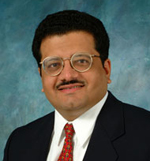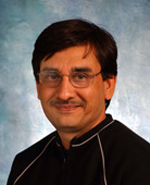 |
Sanjay Singh, M.D. |
 |
Dhirendra Pratap Singh, Ph.D. |
In laboratory studies on brain cells, the enzyme — known as Peroxiredoxin 6 — was shown to drastically reduce the number of cells that were killed by oxidative stress.
“Usually when we do tests such as these, we have to do cell counts to compare samples but in this case, you could tell just by looking at the samples that the cells that were protected by the enzyme survived at a much higher rate,” said Sanjay Singh, M.D., director of The Nebraska Epilepsy Center at UNMC and its hospital partner, The Nebraska Medical Center, who was one of the researchers working on this project.
Dr. Singh and his fellow researcher, Dhirendra Pratap (D.P.) Singh, Ph.D., a professor in the department of ophthalmology and visual sciences, said that by artificially increasing the level of this enzyme and activating its protective properties, the affects of stroke, epileptic seizures and dementia may be drastically reduced.
Dr. D.P. Singh originally realized the power of Peroxiredoxin 6 while working with cataracts, glaucoma and diabetic complications. In his work, Dr. D.P. Singh and his collaborators saw that the enzyme reduced oxidative stress and slowed the onset of these conditions. It did so by optimizing reactive oxygen expression and thereby decreasing cell death.
“Our true savior from oxidative stress-induced or age-associated diseases is this protective protein, Peroxiredoxin 6,” Dr. D.P. Singh said.
Once he realized this, he contacted Dr. Sanjay Singh, whom he met because of some misdirected laboratory equipment.
“Because we share the same last name, I was inadvertently sent some of his equipment,” Dr. Sanjay Singh said. “We started corresponding a bit when I sent him his equipment and through our talks, we eventually found some common research ground.”
After hearing about the enzyme’s protective effects on cataracts, the scientists decided to look into its potential in the brain. They were buoyed when they learned Peroxiredoxin 6 occurs naturally in the parts of the brain that are affected by stroke, epilepsy and dementia.
|
|
Their discovery also sent a wave of enthusiasm through the neurological community.
“The research carried out by this group of scientists at UNMC is very important to millions of patients suffering from common neurological disorders such as stroke, Alzheimer’s disease, epilepsy and Parkinson’s disease,” said Kore Liow, M.D., professor of neurology and director of the Via Christi Comprehensive Epilepsy Center at the University of Kansas School of Medicine at Wichita. “The research also helps scientists from around the world understand how damage to important nerve cells could potentially be prevented by this novel neuroprotective agent being studied in this research.
“These exciting findings and will certainly shed light in our understanding of how better to protect neuronal cells under stress, which has wide implication in a variety of disorders in brain, spinal cord and nerve injury.”
The UNMC scientists also were asked to present their findings last spring at the prestigious Future of Neuroscience Conference at the annual meeting of the American Academy of Neurology in Chicago.
The next step for the UNMC team is to test the enzyme in animal models before potentially moving on to human trials.
“If we can find some way to increase the levels of this enzyme, either through medication or maybe even through diet, it could be a huge potential development in the world of neurology,” Dr. Sanjay Singh said.